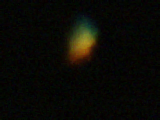I finally managed to get a recognizable look at Venus. The gibbous phase is clearly visible as Venus progresses towards its greatest eastern elongation that will occur on November 1st (at that time it will have maximum distance from the Sun and appear “half lit”). As Venus is always hidden under 100% cloud cover, there are no surface details visible even at the best of times.
The image was taken around sunset when the sky was still very bright to catch Venus as high as possible, but even so Venus was already very low in the sky (~10° altitude from 52°N). Due to the short exposure times, the sky appears mostly black anyway. Here is an unprocessed sample frame for comparison:
As can be seen, imaging through that much atmosphere severly degrades image quality. Turbulence in the air smears the image, and dispersion (due to wavelength-dependency of refraction) turns objects into little rainbows (in fact, for bright objects the atmosphere can be used as a poor man’s spectograph).
However, stacking multiple of these short exposures averages out some of the distortion, while the rainbow effect can be diminished by aligning all color channels individually. I took about 20,000 frames at 0.5 ms exposure over a period of about 4 minutes, 10,000 of which were used for the image presented here.
Saturn is currently located a little to the upper left of Venus (for Nothern Hemisphere observers). It is certainly not a reasonable time to image Saturn, but it was the logical target after Venus:




